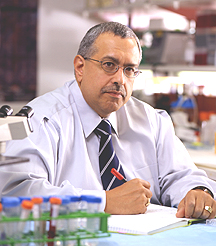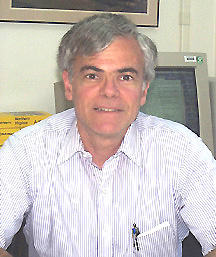

| T H E N I H C A T A L Y S T | S E P T E M B E R – O C T O B E R 2006 |
|
|
|
FROM THE DEPUTY DIRECTOR FOR INTRAMURAL RESEARCH AND THE DIRECTOR OF THE TRANS-NIH RESEARCH INITIATIVES
TRANS-NIH INTRAMURAL SCIENTIFIC INITIATIVES
 |
| Juan Rivera |
 |
| Michael Gottesman |
High-risk, high-impact science is key to the success of the intramural research program (IRP), and, indeed, the IRP embodies the means to undertake that kind of science. Although some of the most far-reaching, cutting-edge science initiatives are beyond the scope of an individual investigator or a single institute or center (IC), the sheer size of the IRP, in both scientific talent and resources, provides the landscape for conducting cutting-edge research not likely to be accommodated elsewhere.
In the past four months, many NIH investigators representing most ICs have participated in a process to identify interdisciplinary science initiatives that promise clear benefits to the scientific community (both intramural and extramural) and, ultimately, to the public health—and that need the leadership of an entity of the magnitude of the NIH IRP to come to life. Some of the general objectives of this effort are to:
![]() Identify unexploited scientific opportunities
Identify unexploited scientific opportunities
![]() Harness the unique features of the IRP
Harness the unique features of the IRP
![]() Encourage trans-NIH and intramural-extramural interactions
Encourage trans-NIH and intramural-extramural interactions
![]() Tap the creativity and talent of IRP investigators
Tap the creativity and talent of IRP investigators
![]() Give IRP scientists a stake in new scientific initiatives
Give IRP scientists a stake in new scientific initiatives
Here we report on the progress of what we call the Trans-NIH Intramural Research Initiatives and discuss what is needed to implement the ideas chosen for further development.
Start-Up
First, ICs nominated "out-of the-box" thinkers from their ranks to participate in this process. In May of this year, an organizational meeting was held that resulted in the formation of six nonspecialized interdisciplinary think-tank work groups. These groups were to discuss the challenges and rewards of proposed innovative projects that might best be done as a collective IRP effort. After vetting the ideas put forward, each group nominated those thought to be of highest caliber for presentation and general discussion at a retreat to be held in Landsdowne, Va., on July 31, 2006. An additional bonus of the retreat was the opportunity for IRP scientists to interact and discuss with NIH Director Elias Zerhouni some of the issues facing the IRP and science in general. We heard a strong consensus for a continuation of these types of meetings in the future.
The retreat discussions identified four scientific areas of broad consensus for IRP involvement:
![]() Translational initiatives that take advantage of the Clinical Center and
the strong laboratory-based immunology at NIH
Translational initiatives that take advantage of the Clinical Center and
the strong laboratory-based immunology at NIH
![]() Imaging initiatives that focus on high-resolution technologies
Imaging initiatives that focus on high-resolution technologies
![]() Systems-biology initiatives that allow collection and analysis of large
data sets to understand molecular networks in health and disease
Systems-biology initiatives that allow collection and analysis of large
data sets to understand molecular networks in health and disease
![]() Drug-discovery initiatives that allow the development of drugs for orphan diseases
as well as the use of novel drugs in clinical trials
Drug-discovery initiatives that allow the development of drugs for orphan diseases
as well as the use of novel drugs in clinical trials
Recommendations to stimulate trans-NIH initiatives included:
![]() Large branch-lab-center structures working on single projects
Large branch-lab-center structures working on single projects
![]() Stimulation of collaborations across NIH
Stimulation of collaborations across NIH
![]() Increased availability of core resources, especially for smaller ICs
Increased availability of core resources, especially for smaller ICs
![]() Geographic co-localization to stimulate creative science
Geographic co-localization to stimulate creative science
![]() Mechanisms for transfer of funds across ICs
Mechanisms for transfer of funds across ICs
![]() Additional
competitive funding (similar to the Bench-to-Bedside or IATAP [intramural AIDS-Targeted
Antiviral] programs)
Additional
competitive funding (similar to the Bench-to-Bedside or IATAP [intramural AIDS-Targeted
Antiviral] programs)
![]() Improved communication (at all levels)
Improved communication (at all levels)
![]() Development of training programs in the quantitative and clinical sciences
Development of training programs in the quantitative and clinical sciences
Some of these needs are already being addressed. For example, educational training initiatives to attract physical scientists and engineers as well as training programs in translational and clinical investigations are part of the efforts underway in the Office of Intramural Training and Education. Others of these are likely to be addressed in the planning and implementation of the particular science initiatives, and still others will be discussed with the IC scientific directors in an effort to stimulate trans-IC cooperation.
Homing in
At a subsequent meeting August 4, the working group co-chairs selected three of the proposed initiatives with the intent of using them as models on which to build future initiatives:
![]() A translational initiative on immunity, autoimmunity, and inflammation that
would also inform the development of initiatives in other areas such as neuroscience
and stem cell research
A translational initiative on immunity, autoimmunity, and inflammation that
would also inform the development of initiatives in other areas such as neuroscience
and stem cell research
![]() An imaging initiative on the development of high-resolution technologies
to visualize molecules to cells that would focus on protein structure and high-definition
resolution of single molecule movement in a cell
An imaging initiative on the development of high-resolution technologies
to visualize molecules to cells that would focus on protein structure and high-definition
resolution of single molecule movement in a cell
![]() A
systems-biology initiative on molecular networks in cell activation and differentiation
that would yield a framework for collecting and processing large data sets in
multiple areas of interest (see also cover story on the
initiation of a NIAID systems-biology program).
A
systems-biology initiative on molecular networks in cell activation and differentiation
that would yield a framework for collecting and processing large data sets in
multiple areas of interest (see also cover story on the
initiation of a NIAID systems-biology program).
It was recommended that topic-specific implementation committees be formed to begin the detailed planning phase, and these committees are now meeting. It is important to note that implementation of these particular initiatives is expected to involve the creation of the infrastructure to facilitate other trans-NIH initiatives.
We emphasize that this effort is open to the IRP scientific community at large, and we encourage your participation in this process. The future of these efforts depends highly on how we as a community seize this opportunity. There has been a remarkable spirit of volunteerism that is greatly appreciated; it has been a hallmark in these efforts.
Not everyone can be a committee member, but this fact should not discourage you from forwarding your ideas to the committee chairs or members. The current committee membership will be posted October 1 on the Office of Intramural Research website.
Discussions between the members of the IRP scientific community and the committees are likely to result in more flexible and accessible structures that are critical to the long-term goals of NIH.
—Juan Rivera, Director, Trans-NIH Research Initiatives
—Michael Gottesman, DDIR